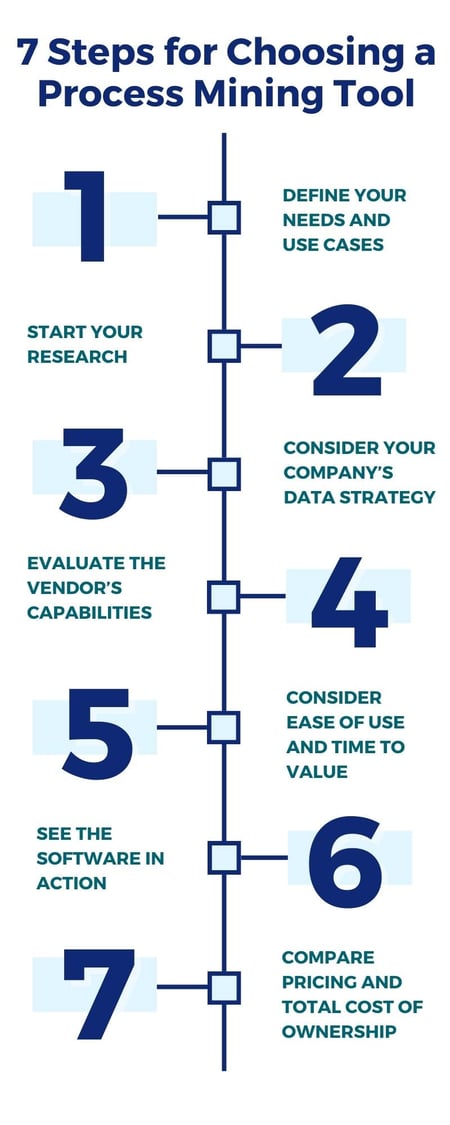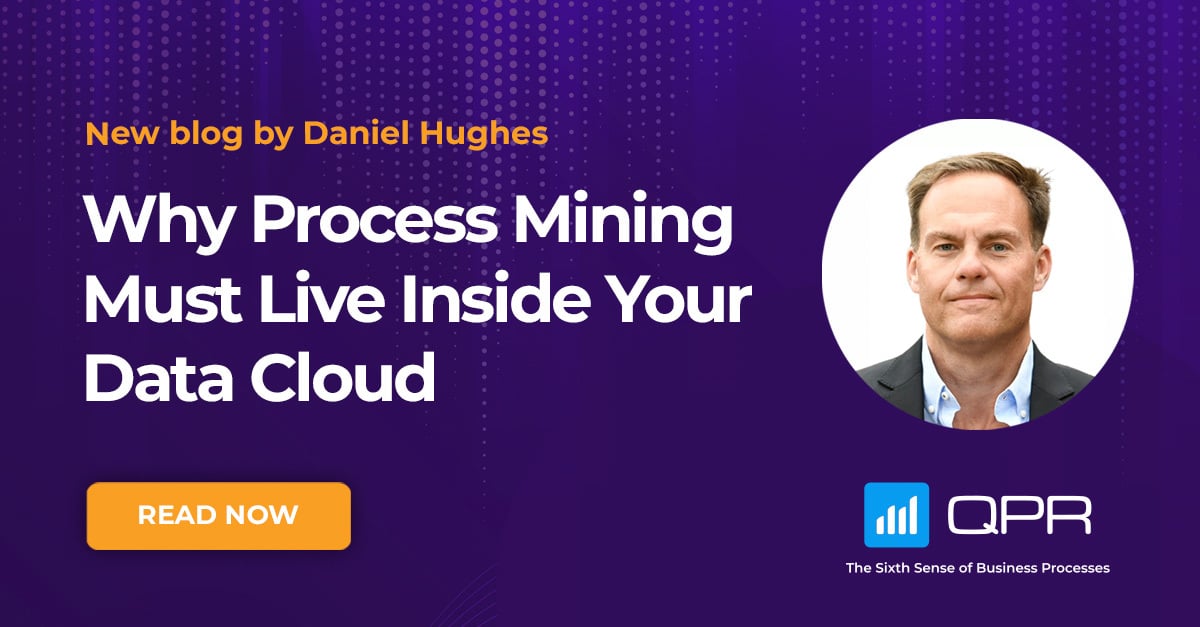How to choose the right process mining vendor for your business
Process mining is critical for businesses that want to optimize their operations, reduce costs, and improve customer satisfaction. However, choosing the best process mining vendor can be daunting, with numerous vendors offering a range of features and capabilities.
In this article, we'll provide a comprehensive guide on choosing the best process mining vendor for your business. We'll cover everything from identifying your needs to evaluating vendor capabilities, ease of use, pricing models, and vendor reputation.
At QPR, the steps we’ve seen companies succeed with when choosing a process mining vendor are as follows:
-
Define your needs and use cases
-
Start your research
-
Consider your company’s data strategy
-
Evaluate the vendor’s capabilities
-
Consider ease of use and time to value
-
See the software in action
-
Compare pricing and Total Cost of Ownership

Step 1: Define your company's needs and use cases
The first step in choosing the best process mining vendor, like any other software or product implementation, is identifying your needs. Process mining helps your company analyze and optimize various processes across the board, from supply chain management to customer service. However, different vendors may specialize in certain types of processes or industries.
By identifying your needs, you can narrow your search to vendors offering the features and capabilities you need. You can also avoid overspending on unnecessary features or missing out on essential ones.
One thing to note at this point is that while it is important to consider your potential future needs, you don’t need to know every use case your business may have in the beginning. It’s perfectly fine (and even encouraged) to begin with one main use case and plan to add more as your business adapts to process mining.
When researching process mining vendors, it’s important to keep the specific processes you want to optimize in mind.
Some vendors are capable of analyzing several processes (and have a licensing system that supports this), while others are limited to analyzing a single process. Other examples of standard features you may want to research include data integration, process visualization, and analysis capabilities.
Data integration refers to the tool's ability to connect to your data sources. It is essential to consider whether the tool can handle multiple data sources, such as ERP systems, CRM systems, and spreadsheets. Some vendors offer pre-built connectors to common data sources, while others may require custom integration.
Process visualization refers to the ability of the tool to create visual representations of your business processes. This is essential for identifying bottlenecks and inefficiencies in your operations. Consider the level of customization you require, such as the ability to create custom process maps and drill down into individual process steps.
Analysis capabilities refer to the ability of the tool to analyze your data and identify patterns and trends. Consider the types of analyses that you require, such as trend analysis, root cause analysis, and performance analysis.
You should also consider the level of customization that your business requires. For example, some vendors offer highly customizable platforms that allow you to create your own analytics and visualizations, while others have a more standardized approach.
Step 2: Start your research
Once you have defined your needs, you can start researching potential vendors. Look for vendors with experience in your industry and a proven track record of successful implementations.
Check vendor reviews on platforms like G2 or Capterra, ratings and customer feedback to gauge their reliability and customer support. Finally, consider the vendor’s pricing model and whether it aligns with your budget.
Considering the vendor’s expertise and knowledge in process mining is also important. Some vendors may have a particular focus, such as compliance, quality management or RPA, while others may have a more general approach. On the whole, try to gauge whether the vendor’s expertise aligns with your business objectives.
Another factor to consider is the vendor’s customer support. Look for vendors that offer comprehensive documentation, training materials, and responsive support channels. Consider the level of support that you require, such as phone support, email support, or chat support.
Step 3: Define your company’s data strategy
An important step in the search for a process mining vendor that many companies overlook is the relationship between a company’s data strategy and its process or operational strategy.
Quite often, a company’s data department will have a strategy that encompasses the way data is collected, stored and utilized, and not always is that strategy communicated clearly (or frequently enough) with the process team when it’s time to make decisions about software like process mining tools.
For a deeper look into aligning your process mining and data strategy decisions, check out this blog post.
Step 4: Evaluate the vendor’s capabilities
After starting your research on potential vendors, next up should be to evaluate their capabilities based on your list of requirements. Consider the following factors when evaluating vendor capabilities:
- Data sources: Does the vendor support the type of data you need to collect? Can it integrate with your existing systems, such as ERP or CRM? Does the data cloud you use (for example, Snowflake, Google or SalesForce) integrate seamlessly with the chosen platform?
- Process discovery: Does the vendor offer automated process discovery, or do you need to manually create process models?
- Process visualization: Does the vendor offer interactive dashboards and visualizations to help you understand your processes better? What’s available out of the box, and what is needed to purchase additionally?
- Process analysis: Does the vendor offer advanced analytics and machine learning algorithms to help you identify bottlenecks, inefficiencies, and opportunities for improvement?
- Process monitoring: Does the vendor offer real-time monitoring and alerting to help you detect and address issues as they arise?
- Industry specialization: Does the vendor specialize in certain industries or processes (in other words, yours!)
It is also important to evaluate the vendor’s approach to data security and privacy. Make sure that the vendor is compliant with relevant regulations, such as GDPR or HIPAA, and that they have measures in place to protect your data.
Consider the scalability of the tool, both in terms of data volume and functionality. The tool should be able to handle increasing data volumes and complexity as your business grows. Consider the vendor’s roadmap and their ability to adapt to changing market needs. Consider whether the vendor offers regular software updates and new feature releases.
Step 5: Consider ease of use and time to value
Process mining tools can be complex, so having an intuitive and user-friendly front end makes things feel a lot simpler.
Look for vendors that are able to show you how to use their platform with your own data, rather than demo data. Additionally, consider the level of technical support and training that the vendor offers to ensure that your team can effectively use the software.
When evaluating the ease of use of the software, either during a demo or in the trial period of a platform, consider:
- User interface: Is the vendor's user interface intuitive and easy to navigate? Can you customize the dashboard and reports to fit your needs?
- Onboarding: Does the vendor offer onboarding and training programs to help your team get started quickly and efficiently?
- Templates: What comes as standard out of the box? If a business user without technical competence can create process-mining workflows on the fly without needing custom code or formula, it’s a huge plus.
- Needs of different users: In reality, not all process mining users are technical specialists – while some people want to get their hands dirty in queries and code, some simply need to view and analyze dashboards.
- Support: Does the vendor offer technical support and troubleshooting assistance? Can you access support via email, phone, or chat? An important question to ask a vendor is how quickly they (on average) respond to user queries and support requests. Of course, the shorter, the better.
- Documentation: Does the vendor provide comprehensive documentation, tutorials, and guides to help you learn (and communicate with your team about) how to use the software?
Step 6: See the software in action
Like any other piece of software, testing the tool or seeing it live in action is an essential step in selecting the one that’s best for your business. Most vendors offer a free trial, allowing you to test the software’s functionality and performance.
During the trial period, make sure to use your real business use cases to evaluate the software’s ability to analyze your data and identify opportunities for optimization.
If a trial period isn’t offered, make sure the vendor is able to provide a demo with your own data. This way, you can see how using their tool will actually look for your business.
During the testing phase, consider the ease of use of the software, the accuracy of the results, and the level of detail provided. Evaluate the software’s ability to create custom visualizations and analytics, and its ability to handle complex data structures.
It is also important to evaluate the software’s integration capabilities – is it able to connect to your data sources, and can it handle the data volumes and complexity of your organization? Consider the time required to set up the integrations and whether it requires any custom development.
Now, we hear you asking: what about getting a proof of concept created?
Think about it this way: what’s the point of test-driving a car?
To get a feeling of how the car drives, right?
In the same vein, do you need to test drive the car 200km and back when you can get a sufficient idea of the look and feel by driving around the neighborhood?
The thing about proof of concepts is that they’re often costly (particularly in terms of internal resources) and an unnecessary effort from the buyer’s side, when in reality, the vendor should be able to prove in the sales phase (through demos, walkthroughs and potentially a free trial) how their platform can be applied to your company’s use cases.
In many cases, the proof of concept is simply not necessary if the demo and sales period have been in-depth and personalized.
Step 7: Compare pricing and Total Cost of Ownership
The final step in selecting a process mining vendor is to consider the total cost of ownership (TCO). The TCO includes not only the upfront cost of the software but also ongoing costs such as maintenance, training, and support.
Evaluate the vendor’s customer support and training resources, as these can affect the TCO. Consider the availability of online training, documentation, and support channels, as well as the responsiveness of the vendor’s support team.
Process mining vendors offer a variety of pricing models, from one-time license fees to subscription-based models. It's essential to evaluate each vendor's pricing model and determine which fits your budget and needs. Some vendors may offer different pricing tiers based on the number of users, data sources, or features.
Quite a few elements go into pricing, so consider them both separately and as a whole:
- License fees: Does the vendor charge a one-time license fee, or is it a subscription-based model? Is the pricing tiered based on the number of users, data sources, or features?
- Contract length: What is the length of the contract? Can you opt for a month-to-month subscription or a longer-term commitment?
- Customization: Does the vendor offer customized pricing plans based on your specific needs and requirements?
- Additional costs: Are there any additional costs, such as training, support, or maintenance fees?
Conclusion
If we were to add just one more step, it would be to use your intuition.
What feeling do you get when speaking to a vendor? Do you feel like they’re passionate about their solution? Do they ask good questions about your specific use cases, and take their time to learn more about your business needs? At the end of the day, the vendor you choose will be a part of your business for (hopefully) a long time — so it’s important they care.
Selecting the right process mining vendor can be a complex and challenging task. However, by defining your needs, researching potential vendors, evaluating their capabilities, testing the software, and considering the total cost of ownership, you can make an informed decision that aligns with your business objectives.
It’s also equally as important to consider the vendor’s expertise, customer support, and approach to data strategy, security, and privacy, as well as their integration capabilities.
By following these steps and taking a comprehensive approach to vendor selection, you can choose a process mining tool that drives efficiency and brings clarity to your business processes.
If you’d like to talk more about process mining vendors, and perhaps whether QPR could be the one for you, get in touch below.
You may also like
These related stories

Why process mining must live inside your data cloud

Process mining for digital transformation

